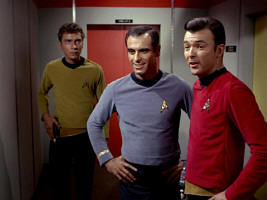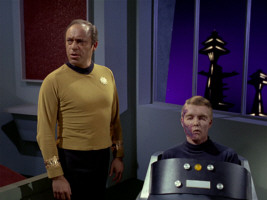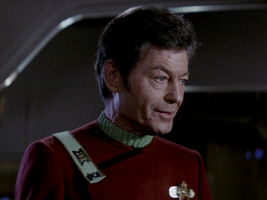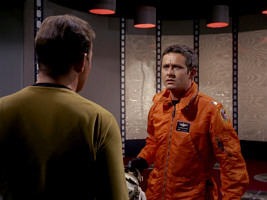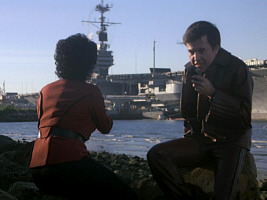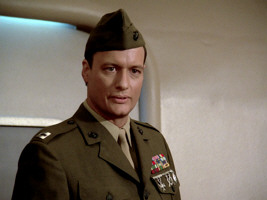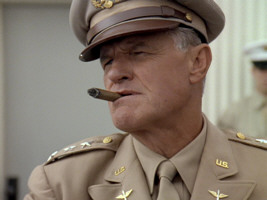Military References in Star Trek
Originally created by FleetCaptain et al. for Memory Alpha
Rank Structure on the EnterpriseEvolution of Rank InsigniaMilitary References in Episodes and Films Star Trek Personalities with Military Service
 This article is not updated any longer. More on some topics can be found in United States military at Memory Alpha.
This article is not updated any longer. More on some topics can be found in United States military at Memory Alpha.
Rank Structure on the Enterprise
According to Inside Star Trek: The Real Story, Roddenberry's original idea for the organization of the USS Enterprise was that the ship would be based on a merchant marine type organization with a Captain and various mates overseeing a large crew. In the pilot episode "The Cage", the only ranks spoken of were Captain, Lieutenant, Chief and Crewman. All officers wore a single rank stripe and, according to Roddenberry, everyone aboard the Enterprise was a qualified astronaut making rank titles a formality since all crewmembers basically had the same type of training.When the second pilot was being developed (TOS: "Where No Man Has Gone Before"), Roddenberry shifted focus from a merchant marine vessel to a military ship very clearly modeled after the United States Navy. The ranks of Lieutenant Commander and Commander were both spoken of and Captain James T. Kirk wore a "two stripe" insignia to differentiate him from the rest of the crew. When Star Trek: The Original Series came into full production, Ensign and Lieutenant Junior Grade were both either seen or discussed and the concept of staff versus line officers was introduced, most predominately in "Court Martial" where an officer of the Judge Advocate General Corps is seen and Starfleet is referred to as "the service".
Evolution of Rank Insignia

The Enterprise breast insignia with Command division device.
![Captain insignia, similar to USN LCDR stripes [1]](military_references/military-tos-captain-t.png)
Captain insignia (23rd century), similar to USN LCDR stripes

Captain pips (24th century), similar to USN sleeve stripes.
When "The Cage" was first produced, personnel aboard the USS Enterprise wore a heavy velor fabric shirt with a breast insignia, within which was a type of specialty crest. The crest placed within the breast insignia indicated the type of position a person held aboard a starship with the senior officers (Captain and First Officer) wearing an arrowhead device. Other personnel wore different insignia depending on their specific job description.
"The Cage" and TOS: "Where No Man Has Gone Before" also showed different shades of brown shirts, depending on if a character was in a command position or if they were in a ship's service role, as well as blue shirts for those attached to medical or scientific duties. The idea of different colored shirts to denote what department of the ship someone served in became much more pronounced in TOS: "The Corbomite Maneuver" when the classic "red, blue, gold" shirt pattern emerged.
The colored shirt theme, combined with the breast insignia device, was the standard means of identifying the area of the ship a character worked in as well as what branch of Starfleet they served in. This concept seems to be based on the practice of line and staff naval officer insignia, which is worn above the sleeve stripe rank on standard U.S. Navy uniforms (Staff Corps / LDO and Warrant).
While the original rank insignia from "The Cage" consisted of a one stripe system for all officers, by the time frame of TOS: "The Corbomite Maneuver", a much more militaristic rank insignia had developed which was very clearly based on the sleeve stripe insignia of the United States Navy. According to costume notes, the very first concept for Starfleet insignia was to be the same as the United States Navy, but Roddenberry altered this slightly so that the characters in Star Trek would not appear "so military". Thus, the Starfleet insignia design featured less sleeve stripes than the actual U.S. Navy, the reason being that the Starfleet design had no insignia for an ensign and a thin half stripe for a lieutenant junior grade. In the real U.S. Navy, an ensign begins with one full stripe (the same as a Starfleet lieutenant) leading up to four stripes for captain. Thus, when comparing Starfleet to the United States Navy, a captain's rank insignia would equal the insignia worn by a lieutenant commander.
In TOS: "The Menagerie, Part I", Starfleet flag officer insignia is seen for the first time with the insignia for a Starfleet Commodore almost identical to that of a U.S. Navy one star admiral. During the entire run of Star Trek: The Original Series, only once was an officer above the rank of commodore seen, this being Admiral Fitzpatrick in TOS: "The Trouble with Tribbles". Fitzpatrick's insignia had often been equated to that of a Vice Admiral, although he was only addressed as "Admiral".
The Starfleet uniforms introduced in "Star Trek II: The Wrath of Khan" featured a much more complex system of shoulder insignia, colored undershirts to denote branch specialty, as well as sleeve insignia system designed to show years of service in Starfleet. According to Robert Fletcher, who designed the uniforms seen in "Star Trek II", the outfits were based on a "Horatio Hornblower" look to convey the feeling that Starfleet was a military organization. These uniforms would be featured in several films ranging from "Star Trek II" to "Star Trek Generations" as well as several flashback episodes of Star Trek: The Next Generation.
The Starfleet uniforms seen in The Next Generation, and the subsequent productions of Star Trek: Deep Space Nine and Star Trek: Voyager returned to the colored shirt method of identifying branch specialty as well as utilizing a series of rank pips were based on the insignia of the U.S. Navy. Under the new "pip system", an ensign insignia was shown as one pip (similar to the United States Navy insignia of a single stripe) and a captain showed four pips. Lieutenant commander and lieutenant junior grade used a "hollow pip" which was based on the half stripe used for these ranks in the U.S. military.
Military References in Episodes and Films
Several Star Trek episodes and films have had characters using military terms or coming into contact with U.S. military personnel. Such productions include:
The Original Series
- TOS: "Where No Man Has Gone Before": Starfleet Academy is mentioned as well as a reference to Starfleet being called "the service".
- TOS: "Mudd's Women": It is established that Starfleet captains, much like modern day naval counterparts, have authority to convene a Board of inquiry to investigate certain situations.
- TOS: "Balance of Terror": Written along the lines of a destroyer-submarine conflict, this episode is full of military terms, including various shipboard alerts and damage control jargon, as well as establishing that Starfleet is a tasked with defending the United Federation of Planets.
- TOS: "Dagger of the Mind": Captain James T. Kirk tells Tristan Adams that Starfleet regulations require an investigation into the events at the Tantalus Penal Colony.
- TOS: "Court Martial": This episode explains that Starfleet has a military court system very similar to that used by the United States armed forces.
- TOS: "The Menagerie, Part I" and "The Menagerie, Part II": The court martial system is again seen as well as a reference to Starfleet General Orders.
- TOS: "Tomorrow is Yesterday": The crew of the USS Enterprise come into contact with several members of the United States Air Force. James Kirk tells John Christopher that Starfleet is a "combined service" when asked if the Enterprise was part of the United States Navy.
- TOS: "Errand of Mercy": Starfleet is described as consisting of dozens of starships which can form fleets to stop an invasion force. James Kirk refers to himself in this episode as a "soldier".
- TOS: "The Doomsday Machine": Starfleet regulations are again discussed, including the rights of a Medical officer to relieve a Commanding officer who is acting irrationally.
- TOS: "The Trouble with Tribbles": A Starfleet Admiral is seen for the first time.
- TOS: "By Any Other Name": It is mentioned that Starfleet has "handled foreign invasions before".
- TOS: "The Savage Curtain": Captain Kirk's tactics are compared to those of Ulysses Grant.
- TOS: "Turnabout Intruder": Court martial proceedings are again seen as well as discussions about medical regulations allowing for the relief of a commanding officer for cause.
Star Trek films
- "Star Trek: The Motion Picture": The Starfleet Reserve is indirectly mentioned through the Reserve activation clause. Regulations are discussed where an admiral can take command of a starship in an emergency situation. While real world military regulations do exist for this occurrence, unlike the procedure seen in ST:TMP, this does not involve demoting the current captain to the rank of commander.
- "Star Trek III: The Search for Spock": A Starfleet Fleet Admiral is seen for the first time as well as the first promotion of a non-command officer (Montgomery Scott) to the rank of captain.
- "Star Trek IV: The Voyage Home": Pavel Chekov is taken prisoner onboard the aircraft carrier USS Enterprise CVN-65 (actually the USS Ranger CV-61 as a stand-in) and comes into contact with several United States Navy personnel.
- "Star Trek VI: The Undiscovered Country": Award ribbons are seen for the first time on the red jacket uniforms of Starfleet Admirals. The awards are positioned in the same manner as present day Awards of the American military. In the video and DVD releases of the movie Colonel West explains the plans to rescue Kirk and McCoy. He wears a Starfleet uniform, but with the rank insignia of a vice admiral.
- "Star Trek: Insurrection": Vice Admiral Matthew Dougherty is referred to as the military commander of a sector.
The Next Generation
- TNG: "Encounter at Farpoint": Q impersonates a captain of the United States Marine Corps, to include using the saying "All it takes are a few good men" (the recruiting slogan of the USMC at the time that the pilot of The Next Generation was produced).
- TNG: "The Neutral Zone": Ralph Offenhouse states to Jean-Luc Picard that a military career does not involve that much business sense.
- TNG: "The Measure Of A Man": The Starfleet Judge Advocate General Corps is seen for the first time since The Original Series. A staff captain also appears and it is discussed that Starfleet regulations require a Court martial for any captain who loses his or her starship to an accident or enemy action.
- TNG: "The Icarus Factor": The promotion method to Commanding officer and First officer are discussed as being partially determined by vacancies in the Starfleet when someone retires.
- TNG: "Peak Performance": It is observed that a person can be captain of a starship without actually holding the rank of captain (i.e. Commander William T. Riker in command of the Hathaway.)
- TNG: "Yesterday's Enterprise": A "military log" is mentioned in an alternate timeline.
Deep Space Nine
- DS9: "Little Green Men": Quark, Nog, and Rom travel back in time and encounter members of the U.S. Army Air Forces.
- DS9: "Far Beyond the Stars": Benny Russell's space station design is labeled "USAF".
Voyager
- VOY: "Future's End": After traveling back in time, a shuttlecraft from the USS Voyager is mistaken for a military aircraft due to the annotation "USS" on its hull.
Enterprise
- ENT: "Minefield": Malcolm Reed's family history in the Royal Navy is discussed as well as his great-uncle dieing in a submarine accident.
- ENT: "The Expanse": A detachment of MACOs under Major Hayes is assigned to Enterprise NX-01. The MACOs (Military Assault Command Operations) are not associated with Earth Starfleet, and their rank structure is similar to that of the U.S. Marine Corps.
- ENT: "First Flight": The Starfleet test pilot program is discussed, similar in its description to modern day military test flight programs.
- ENT: "The Xindi": The Command center is introduced, somewhat similar to concept of a Navy Combat Information Center.
- ENT: "Storm Front": Enterprise NX-01 travels back in time to 1944 where it encounters an alternate timeline. It is mentioned that the aircraft carrier Enterprise has been sunk in this reality.
Star Trek (2009)

- "Star Trek (2009)": We can see at least two old USAAF patches behind the bar in Iowa.
Star Trek Personalities with Military Service
In addition to military references in Star Trek productions, a fairly large number of Star Trek personalities have actually served in the United States armed forces. The largest number are Original Series actors, producers, and writers, with service in the Second World War. A fair number have service in the Korean War time frame and background actor Newell Tarrant is the only Star Trek actor known to have served in the Vietnam War.
Likewise, many Star Trek personas with service in World War II have either damaged military records or no military records at all due to a major fire in 1973 which destroyed 18 million military files at the National Personnel Records Center in St. Louis.
None of the actors who have portrayed Starfleet captains in the major series (Shatner, Stewart, Brooks, Mulgrew, or Bakula) have ever served in the military. William Shatner, however, did appear as an Army captain opposite Spencer Tracy (who served in the US Navy during World War I) in the film "Judgment at Nuremberg" shortly before Shatner's appearance in Star Trek.
While never having served in the military, Michael Dorn has spent many years involved with the Civil Air Patrol and is a skilled and accomplished pilot. James Doohan and David Hurst are the only known Star Trek actors to have served in an armed force other than the United States military. Doohan served in the Canadian Army and Air Force and Hurst served in the British Army's Irish Fusiliers; both actors were veterans of the Second World War.
| Individual | Star Trek role | Branch of service | Years of service | Service number | Final rank |
|---|---|---|---|---|---|
| Whit Bissell | Lurry | US Army | 1943 - 1945 | 39 708 296 | Sergeant |
| Elisha Cook | Samuel Cogley | US Army | 1942 - 1943 | 39 531 145 | Private First Class |
| Gene L. Coon | Original Series Producer | US Marine Corps | 1942 - 1946 1950 - 1951 |
442994 | Sergeant |
| Harlan Ellison | Script Writer (TOS: "The City on the Edge of Forever") | US Army | 1957 - 1959 | 51 403 352 | Private First Class |
| Morgan Farley | Hacom / Yang Scholar | US Army | 1942 - 1945 | 530425 | Second Lieutenant |
| Paul Fix | Mark Piper | US Navy | 1918 - 1919 | 150 83 54 | Hospital Apprentice First Class |
| Fred Freiberger | Original Series Producer | US Army Air Corps US Air Force Reserve |
1941 - 1946 1946 - 1957 |
32001877 673530 |
First Lieutenant |
| Frank Gorshin | Bele | US Army | 1953 - 1955 | 52 314 745 | Not recorded |
| James Gregory | Tristan Adams | US Navy | 1942 - 1945 | 647 86 69 | Petty Officer 1st Class |
| Richard Herd | Owen Paris / L'Kor | US Army | 1953 | 51 214 821 | Private |
| Jeffrey Hunter | Christopher Pike | US Navy | 1945 - 1946 | 960 39 80 | Seaman 1st Class |
| Roy Jenson | Cloud William | US Navy | 1944 - 1946 | 566 72 38 | Seaman 1st Class |
| Robert Justman | Original Series Producer | US Navy | 1944 - 1946 | 881 57 18 | Petty Officer 3rd Class |
| Brian Keith | Mullibok | US Marine Corps | 1942 - 1945 | 385253 | Corporal |
| DeForest Kelley | Leonard McCoy | US Army Air Corps | 1943 - 1946 | 39 563 856 | Private First Class |
| Mark Lenard | Sarek / Romulan commander / Klingon captain | US Army | 1943 - 1946 | 36 858 836 | Technical Sergeant |
| Richard Matheson | Script Writer (TOS: "The Enemy Within") | US Army | 1944 - 1945 | 12 229 310 | Private |
| Lawrence Montaigne | Decius / Stonn | US Marine Corps | 1947 - 1950 | 1060247 | Private First Class |
| Joseph Naradzay | Marine sergeant | US Marine Corps | 1964 - 1990 | 2030237 | Sergeant Major |
| Leonard Nimoy | Spock | US Army Reserve | 1953 - 1955 | 11 229 770 | Sergeant |
| Nehemiah Persoff | Palor Toff | US Army | 1942 - 1946 | 32 698 169 | Technician 5th Grade |
| Gene Roddenberry | Series Creator | US Army Air Corps | 1942 - 1945 | 662606 | Captain |
| David Sharpe | Security Guard (TOS: "Day of the Dove") / Stunt Double (TOS: "Requiem for Methuselah") | US Army Air Corps | 1943 - 1945 | 522005 | First Lieutenant |
| Ron Soble | Wyatt Earp | US Army | 1946 - 1948 1951 - 1953 |
16 231 533 02 103 964 |
First Lieutenant |
| Warren Stevens | Rojan | Naval Academy / Army Air Corps | 1937 - 1940 (Navy) | 139 89 54 | Midshipman |
| Newell Tarrant | Rogerson | US Navy | 1966 - 1986 | Researching | Commander |
| Harry Townes | Reger | US Army | 1942 - 1946 | 32 792 652 | Corporal |
| William Windom | Matthew Decker | US Army | 1943 - 1946 | 33 455 116 | Technician 5th Grade |
| Ian Wolfe | Septimus / Atoz | US Army | 1917 - 1919 | 2371377 | Sergeant |
| Donald W. Zautcke | Marine lieutenant | US Marine Corps | 1981 - 1985 | None | First Lieutenant |
| Anthony Zerbe | Matthew Dougherty | Air Force Reserve / Air National Guard | 1958 - 1964 | 28248934 | Airman 3rd Class |
The military records of Keith Andes, John Hoyt, Matt Jefferies, George Clayton Johnson, and Byron Morrow were completely destroyed in the 1973 National Archives Fire, making service verification impossible. Frank Gorshin's military rank was also damaged to the point that his final rank at discharge is unknown.
Hal Baylor, Hal Lynch, and Steve Sandor are listed in several publications as having military service; however to date neither the Department of Veterans Affairs or the National Personnel Records Center has been able to locate records for these three actors.

United States military @ Memory Alpha
References
- Inside Star Trek: The Real Story by Herbert F. Solow & Robert Justman
- United States Department of Veterans Affairs, VA Index Files
- National Archives and Records Administration (NPRC); St. Louis, Missouri
Credits
This article was created by FleetCaptain et al. at Memory Alpha. The text has been republished in accordance with Memory Alpha's policies. Thanks to Joćo Paulo Cursino and to Adam Rieder for corrections.
The TOS and the TNG rank insignia were created by M.K. Bartel and are used with permission.
Special note FleetCaptain would like to honor Frank W. Buckles (Service#: 15577), who was the last living World War I veteran in the United States.






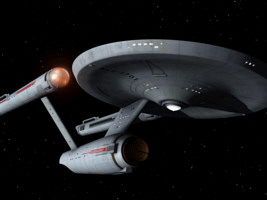
 Starship Enterprise in ENT: "These Are The Voyages"
Starship Enterprise in ENT: "These Are The Voyages"